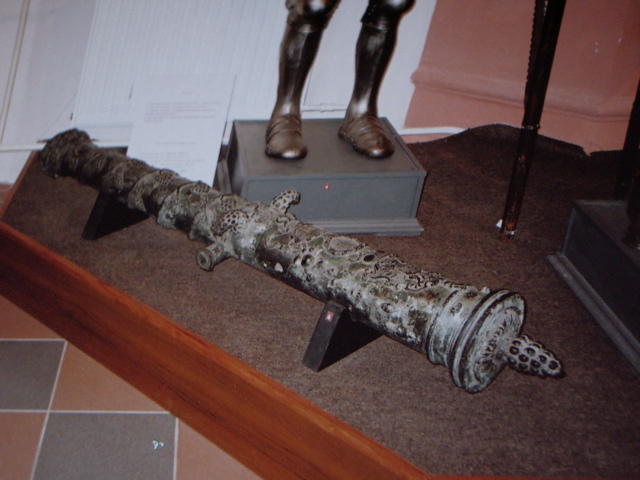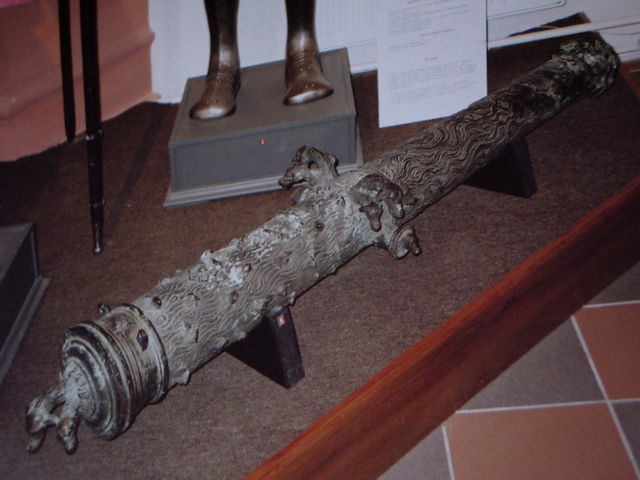

Radzivils' Armory Treasures in Russian Museums
The pictures in this page were taken at the State Museum of Artillery, Corps of
Engineers and Signal Corps in St. Petersburg, Russia. According to the Museum's officer in charge of expositions the cannon tubes as
well as the collection of knight's suits of armor were confiscated from the Radzivils castle after the uprising of 1831 supported by
the ordynat or the ruler of Niasvizh. The confiscated items were placed in the Museum of Artillery and the Hermitage, where now
everyone can see what used to be part of the famous Radzivils' Armory. The cannon tubes from
Niasvizh are of a unique design and
are incomparable pieces of art in the museum's collection, the officer said.
Both cannons bear the Radzivils'
family coat of arms, branded on the sophisticated plant-like and mythological ornament as three hunters'
horns on the Royal Piasty Eagle. Both tubes are marked with Latin inscriptions, one of which reads: "Nicolaus Christophorus Radziwil by
God's Grace the Duke of Nesvizh and Olyka et cetera anno Domini MD?C". All items slightly touched by the 400 years' patina are in
excellent condition due to the care of the museum workers
However, unlike other trophies taken by the victorious Russian Imperial army on the battlefields, the artifacts from Belarus can
hardly be called trophies. By the time of confiscation they could hardly be used for military purposes and had been the
Radzivils' castle museum items for about 200 years already. The only obvious reason for moving them to the Russian Imperial capital city was the
fact that the Russian government liked and wanted them for Russian museum collections.
The addiction of neighbors to Niasvizh
artifacts was so irresistible that the Soviet occupational administration could not but continue to
live up to imperial habits when back in 1939-1941 among other things they tore off even the
Niasvizh castle's valuable ornamental hardwood floor (parquet), blaming
that sin on the German army. According to Belarusan knowledgeable sources the flooring ended up in one of Beria's mansions in Moscow.
Beria was the notorious Soviet security police head and his office's thief skills were practiced in full in Belarus which they took as
another province of the expanding Soviet 'paradise'. After WWII part of the Niasvizh castle museum items and picture gallery was sent to
communist controlled Poland as a 'gift' from the Soviet government. This communist style generosity was demonstrated at the expense of
the people of Belarus. Ignorant Soviet rulers did not care about the fact that the
Radzivils saw difference between Poland (the Crown) and historical Lithuania (the
Duchy), where Belarusan, unlike Polish
or Russian, has always been spoken as a mother tongue of the vast majority of the population and among others by the Dukes of
Niasvizh themselves.
European nations claim their museum items lost in wars, even the ones, started by themselves, like Germany. Belarus has never started
a war or stolen a single museum item from a neighbor. Summing up, what can Belarus offer now for tourist business in its miraculously
restored or renovated castle halls: museum items or replicas? Will the restored historical buildings be turned only in restaurants and
three-star hotels, which can hardly impress and attract tourists without glorious historical contents?
References:
Back to Belarusian Castles and Knighthood page
 This file is a part of the Virtual
Guide to Belarus - a collaborative project of Belarusian
scientists and professionals abroad. VG brings to you the most extensive
compillation of the information about Belarus on the Web.
This file is a part of the Virtual
Guide to Belarus - a collaborative project of Belarusian
scientists and professionals abroad. VG brings to you the most extensive
compillation of the information about Belarus on the Web.
Please send your comments to the authors of VG to
Belarus
History | Statehood | Culture | Law
and Politics | Cities | Nature and Geography |
©2007 VG to Belarus
Disclaimer